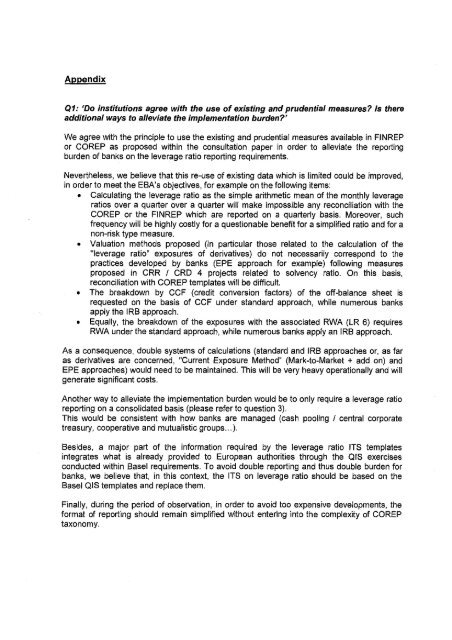FBF - European Banking Authority
FBF - European Banking Authority
FBF - European Banking Authority
Create successful ePaper yourself
Turn your PDF publications into a flip-book with our unique Google optimized e-Paper software.
Appendix<br />
Ql: Do institutions agree with the use of existing and prudential measures Is there<br />
additional ways to alleviate the implementation burden'<br />
We agree with the principle to use the existing and prudential measures available in FINREP<br />
or COREP as proposed within the consultation paper in order to alleviate the reporting<br />
burden of banks on the leverage ratio reporting requirements.<br />
Nevertheless, we believe that this re-use of existing data which is limited could be improved,<br />
in order to meet the EBA's objectives, for example on the following items:<br />
• Calculating the leverage ratio as the simple arithmetic mean of the monthly leverage<br />
ratios over a quarter over a quarter will make impossible any reconciliation with the<br />
COREP or the FINREP which are reported on a quarterly basis. Moreover, such<br />
frequency will be highly costly for a questionable benefit for a simplified ratio and for a<br />
non-risk type measure.<br />
• Valuation methods proposed (in particular those related to the calculation of the<br />
"leverage ratio" exposures of derivatives) do not necessarily correspond to the<br />
practices developed by banks (EPE approach for example) following measures<br />
proposed in CRR / CRD 4 projects related to solvency ratio. On this basis,<br />
reconciliation with COREP templates will be difficult.<br />
• The breakdown by CCF (credit conversion factors) of the off-balance sheet is<br />
requested on the basis of CCF under standard approach, while numerous banks<br />
apply the IRB approach.<br />
• Equally, the breakdown of the exposures with the associated RWA (LR 6) requires<br />
RWA under the standard approach, while numerous banks apply an IRB approach.<br />
As a consequence, double systems of calculations (standard and IRB approaches or, as far<br />
as derivatives are concerned, "Current Exposure Method" (Mark-to-Market + add on) and<br />
EPE approaches) would need to be maintained. This will be very heavy operationally and will<br />
generate significant costs.<br />
Another way to alleviate the implementation burden would be to only require a leverage ratio<br />
reporting on a consolidated basis (please refer to question 3).<br />
This would be consistent with how banks are managed (cash pooling / central corporate<br />
treasury, cooperative and mutualistic groups...).<br />
Besides, a major part of the information required by the leverage ratio ITS templates<br />
integrates what is already provided to <strong>European</strong> authorities through the QIS exercises<br />
conducted within Basel requirements. To avoid double reporting and thus double burden for<br />
banks, we believe that, in this context, the ITS on leverage ratio should be based on the<br />
Basel OIS templates and replace them.<br />
Finally, during the period of observation, in order to avoid too expensive developments, the<br />
format of reporting should remain simplified without entering into the complexity of COREP<br />
taxonomy.
















